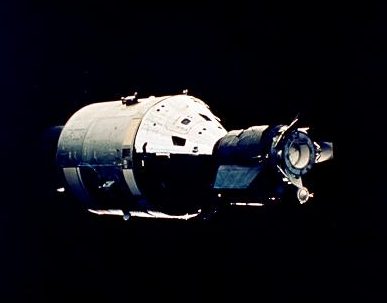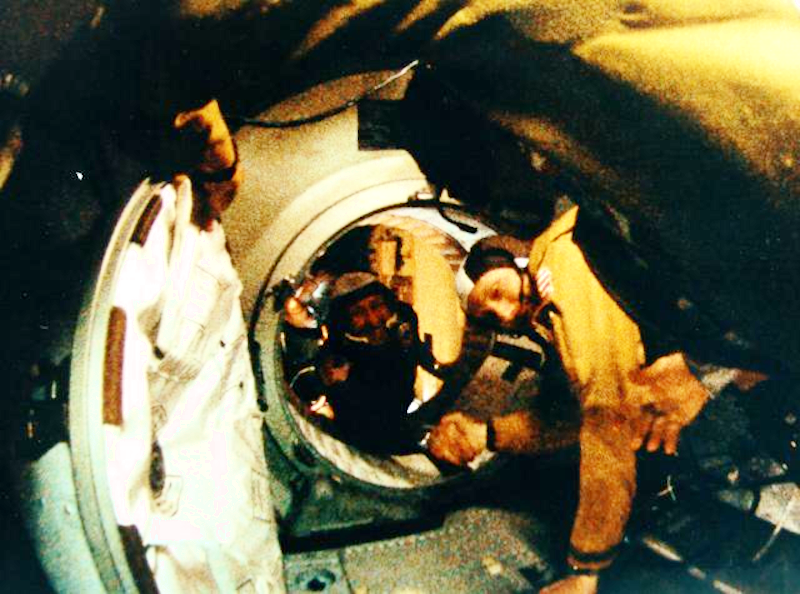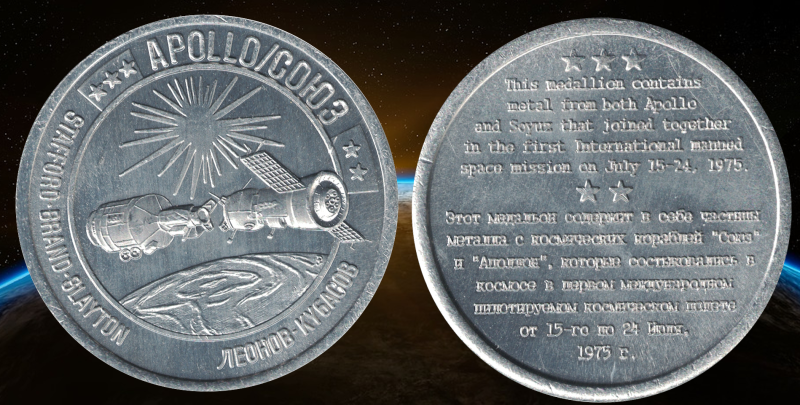If you watched the original Star Trek series, you’d assume there was no way the Federation would ever work with the Klingons. But eventually the two became great allies despite their cultural differences. There was a time when it seemed like the United States and Russia would never be friends — as much as nations can be friends. Yet today, the two powers cooperate on a number of fronts.
One notable area of cooperation is in spaceflight, and that also was one of the first areas where the two were able to get together in a cooperative fashion, meeting for the first time in orbit, 135 miles up. The mission also marks the ultimate voyage of the Apollo spacecraft, a return to space for the USSR’s luckiest astronauts, and the maiden flight of NASA’s oldest astronaut. The ability to link US and Soviet capsules in space would pave the way for the International Space Station. The Apollo-Soyuz mission was nothing if not historic, but also more relevant than ever as more nations become spacefaring.
A Cold War
The Russians and the Americans had been allies in World War II. However, it was an uneasy friendship based more on necessity and common interest than anything else. When the Manhattan Project gave the allies the atomic bomb, the Russians felt vulnerable and set about building their own bombs. This was the start of the so-called Cold War.
In 1957, the Russians launched Sputnik I, the first satellite launched by humans. Today, we’d think that was cool, but in the paranoid times of the Cold War, it struck fear into Americans. If the Russians could put something over our heads and out of reach of our defenses, they could bomb anywhere in the world at will.
The Americans decided they would not take a backseat on putting things in orbit and the space race began. After a slow start and President Kennedy famously announcing “we will go to the moon” things started to move rapidly. That story is well-told and the United States landed on the moon less than a decade later thanks to the Apollo spacecraft–an engineering marvel.
Early Days of Cooperation
In October 1962, right after Glen’s first orbital flight, the Russians and Americans signed the Dryden-Blagonravov agreement to share weather satellite data, study the Earth’s magnetic field jointly, and for the Russians to help track the Echo II satellite. This was viewed at the time, to quote Vice President Lyndon Johnson, “with a spirit of cautious optimism that the Soviet Union appears to realize that – in outer space, at least – there may be something to be gained by cooperating with the rest of humanity.”
But October 1962 also saw the Cuban missile crisis, with the two nations coming as close to nuclear war as ever. Needless to say, this hampered international cooperation in space for a time.
By 1970, the president of the Soviet Academy of Sciences Mstislav Keldys and NASA administrator Thomas Paine exchanged letters regarding more cooperation in space, something both sides saw as a political act of peace. Soviet Leader Leonid Brezhnev said:
The Soviet and American spacemen will go up into outer space for the first major joint scientific experiment in the history of mankind. They know that from outer space our planet looks even more beautiful. It is big enough for us to live peacefully on it, but it is too small to be threatened by nuclear war”
By 1972 an agreement formed and part of that agreement called for the Apollo-Soyuz Test Project or ASTP to launch in 1975.
Apollo-Soyuz
Despite what you see in movies, the technical challenges to joining two spacecraft in orbit are pretty significant. Of course, there’s simply getting near enough to even attempt it, but that’s orbital mechanics. You also need to line up very precisely and control the forces involved as the two massive high-speed vehicles mate.
Then there are other problems. For example, the docking adapter will typically be very cold when you open the airlock and that will cause water to condense from the warm moist air in the spacecraft. So docking and then immediately popping the hatch is a thing only in the movies. In real life they wait for things to warm up, and still have to mop up liquid as they go through the interface between the two vessels.
Speaking of warm moist air, the Apollo command module used pure oxygen at about 5 PSI. The Soyuz used a nitrogen and oxygen mix at a comfortable sea-level pressure of 15 PSI. The ASTP design was to use an adapter that joined the two ships together. Because of the atmosphere differences, the adapter had to operate as an airlock, as well.

NASA and the Academy of Sciences of the Soviet Union worked together to develop the Androgynous Peripheral Attach System (APAS). Unlike earlier docking schemes, like the one used to connect the lunar module to the command module, a ship with APAS could — in theory — attach to any other vessel with APAS. Most docking systems at the time were not like this. You could not dock two command modules or two lunar modules together, for example.
The ASTP Apollo ship didn’t actually use APAS. The adapter was made to look like a lunar module on one side and presented an APAS interface on the other. The Soyuz had a proper ASTP docking ring that could be detached in case of an emergency. There were other changes to the Soyuz. The air pressure, for example, reduced to just over 10 PSI so there was less pressure differential across the adapter.
The Russians actually made six of these modified Soyuz. Two were launched without a crew. One was used for a test mission. Of the two other additional capsules, one had its docking ring replaced with a camera for a later mission and one was a hot backup for the mission that was later taken apart.
Crew
The Russians picked a “lucky” crew of two for the Apollo-Soyuz mission. Alexei Leonov and Valeri Kubasov had both been in space before and Leonov was the first to walk in space. They were “lucky” because they had been slated to fly on Soyuz 11, which ended with all three crew losing their lives, but Kubasov was suspected of having tuberculosis and they didn’t fly. There were two cosmonauts because the Soyuz 11 tragedy demonstrated the need for wearing spacesuits inside the capsule during critical mission phases, and there simply wasn’t room for three.
The American crew consisted of Tom Stafford, Vance Brand, and the previously grounded Deke Slayton. Stafford had made three previous flights but it was Brand’s first.
It was Slayton’s first (and only) flight, but he’d been around since literally day one so he was hardly a neophyte. Slayton was one of the original seven astronauts selected for Mercury. Before he could fly, a relatively minor medical problem sidelined him and he took over as the head of the astronaut office. In Apollo-Soyuz, he would become the oldest person at that time to reach orbit and also the astronaut with the longest time between selection and first flight, a record probably no astronaut wants to break.
The Mission

In July of 1975, both ships launched with experienced, reduced, and “lucky” crews. At the time, the Russians did not typically report on space missions until their completion. However, this mission was televised live. The crews had trained together extensively, so it wasn’t their first meeting when three hours after docking, Leonov and Stafford opened the hatches and shook hands.
They exchanged gifts, shared meals, and conducted joint experiments. They also practiced undocking and docking again. To simplify matters, the Russians spoke English and the Americans spoke Russian. The idea was that you can more easily figure out someone speaking your native language than trying to force one side or the other to speak a single language. Leonov would later joke that the mission used three languages because he called Stafford’s Russian “Oklahomski.” The two men had actually become very good friends and would remain so the rest of their lives.
The mission was a great success. After staying mostly docked for 44 hours, the ships separated and the Apollo capsule produced an artificial solar eclipse so the Soyuz could get pictures of the solar corona. They docked again briefly and then went on to spend more time on solo missions. You can see some of the contemporary news coverage of the actual docking, below.
https://www.youtube.com/watch?v=x4_3D1IvsMQ
Everything was fine until the reentry of the Apollo capsule. A crew error allowed propellant fumes to vent into the capsule. Brand passed out and Stafford was able to unship emergency breathing gear. Although they landed alive, the three would spend several weeks in the hospital because of the accident. The Apollo missions were over. The next American crew would ride the Space Shuttle.
You can see Stafford rubbing his throat as he speaks from the recovery ship’s deck in the NASA documentary you can watch below.
Since the whole idea of ASTP was that it was a joint mission, it seems only fair that we show the Soviet documentary, too. It is really an interesting film and be sure to click on the link to watch the second part.
https://www.youtube.com/watch?v=FpRBfLtnfSg
What Happened to the Hardware?
Some of the spacecraft are on display both at the California Science Center in Los Angeles and the RKK Energiya museum in Moscow. There are also several test articles and replicas at the Smithsonian National Air and Space Museum, the Kennedy Space Center, and several other locations.
Some of the metal from the spacecraft was used to strike some commemorative medallions and I’m fortunate enough to have one — see the picture below — from my stint working on more modern docking systems.
Legacy
Speaking of more modern docking systems, the APAS eventually turned into the APAS-89 which flew on Mir and the Space Shuttle. The ISS has a modified version of APAS-95 which is not androgynous. All of this led to the IDSS or International Docking System Standard which is the current standard for connecting two spacecraft together. Even today, the ISS docking ports connect to an International Docking Adapter (IDA) to convert the older ports to the IDSS standard. It isn’t just a mechanical linkage. Umbilicals can provide power and data between the two vehicles and, eventually, even transfer of some consumables.

Cooperation and Competition
Today, the United States has a greater focus on Mars than the moon. China is going back to the moon aggressively, but since they are not part of the ISS membership for complex political reasons, they are mostly going their own way.
On the one hand, it occurs to me that if you poured all the space funding into one wallet — say under the United Nations — you could spend more on individual space missions. Of course, there are risks to putting all of your eggs in one basket and people might be even less willing to spend on space if they didn’t feel national pride.
So what about friendly competition? Start the space Olympics and compete as national teams. After all, the space race spurred us to the first moon landing. Maybe what people aren’t willing to fund for science, they’d be willing to spend on sport competitions. The taxation for pro sports venues bears that theory out.
Either way, the status quo is some level of cooperation, even if tacit. ASTP was a very visible reminder that two great nations can do more in space than either one of them can do alone. Time will tell if we remember this as we build global space policy in the future.

















“Yet today, the two powers cooperate on a number of fronts.”
And yet, at least one continues to attack the other on electronic fronts with apparently very few reprisals.
Ah yes, it is impossible to plant few cyrillic characters in text file if you live in N. Korea, China, or US …
Flags are waving, and some of them are false.
I hope that spirit of human cooperation will continue. Which means mutual respect, not only one-way respect to “one and only superpower” ™.
Of course, if flag-waving gets us to Moon and Mars sooner, so be it.
Haha, NK successfully covering their trail and implicating Russia? Haha!
You might want to read the rest of that sentence.
+1
Two kids trading punches. One starts to cry, “Mom, Billy hit me!”
The definitive version of this story is from Dubliner Paddy Crosbie’s autobiography: “He started it when he hit me back.”
Ha! That might be my new favorite phrase!
I really wish our “leaders” could get over their selfish ambitions so that the entire world could prosper. I think it’s because science is a noble (rather than material) endeavor for understanding the universe better that you see more people working together. The primal selfishness of people is humanity’s greatest obstacle.
The primal selfishness of people is what led them to develop new technologies and methods. Ford didn’t bring down the cost of cars to so the masses could buy them. He brought down the cost so he could sell more of them. Selfishness is what has caused us to advance every step of the way, wanting to have a better life. Eliminate selfishness? You’ll ingrain stagnation and eliminate progress.
This is a common myth. For the majority of human history, people have worked together in one form or another for the common good. Many act like Ford et. al. prove some underlying human nature that they summarize as “selfishness = progress” without any serious inquiry into the matter. They also conveniently ignore the myriad examples of selfishness causing death, destruction, and even near total annihilation of human life.
Also, Ford was a raging anti-semite and an idol of none other than Hitler.
Using the same equipment, we could have had another Apollo moon mission. I would have preferred that to this political sideshow mission.
Or launched another SkyLab?
No, we couldn’t. The ASTP launched on a Saturn 1B, not a Saturn V. It was an orbital booster only.
There were/are parts at hand for 2 more missions: https://en.wikipedia.org/wiki/Apollo_program#Mission_cutbacks
They are museum pieces now, apparently.
Political sideshows help keep wars from happening.
I agree, to put it into geek parlance the U.N. makes Mos Eisley look like the Jedi Temple. Once the U.N. collapses would you Americans stop pushing for these international talking shops (League of Nations, United Nations, enough alrteady!)
Citations needed.
And those useless, backward Russians are still using basically the same technology to get into orbit while might Uncle Sam has advanced to using um, ah… Да здравствует Россия!
Interestingly, though, the Russian technology turned out to be durable and long-lived. They use technology that they think works well, no matter the age. That’s something I always admired. For example, some of their fighter jets used to operate with miniature electron tubes that were immune against EMPs. The Americans and the western world, on the other hand, stopped using tubes in favor of cheap, fragile solid-state technology because it was ‘in’ and ‘cool’ (pun intended) at the time.
In case you didn’t check the Cyrillic says “Long Live Russia!” (or at least that’s what Google translate told me) so I agree, the Russians use old technology to get into space while, for the time being, the Americans use nothing, viva la retro.
I remember watching the final space shuttle launch as a kid and wondering why they were retiring the space shuttle because “it was time for something new” without having an alternative. Nearly a decade later, they still don’t have their own ship.
We now have a way to get people to and from LEO and the ISS. There’s a crew dragon docked to the ISS as we speak.
I agree. It kind of makes me a bit sad also that the Space Shuttles never had a chance leave to earth orbit. They were real space ships, after all and much more capable of than space capsules. In theory, they had space enough for a dozen crew members, for a laboratory, tools, a little “garden”, to carry food etc. Makes me wish they lasted a bit longer, so they would have had a chance to land on a future space port on moon someday. But not exactly like shown in “Airplane II: The Sequel”. ;)
Correction: THE DAY THE RUSSIANS AND AMERICANS MET 217 KM UP
so am i the only one to wonder how propellant fumes were able to be vented into the capsule period?
via pilot error or otherwise?
that sounds like a HUGE engineering fuck-up to me.
as in heads will roll…
Good question! Propellant fumes in pure oxygen environment! That could have ended with quite a bang.
today USA is cold war with China !!!
China stolen 5G, jobs, money, ..from USA !!
That reminds me of a very old joke,
which was about who (US/USSR) had the better German scientists.. ;)
Seriously though, China is currently challenging the whole world, it seems.
Let’s just hope it turns out to be a friendly competition. :)
If China truly has the will, it could make things better.
Let’s don’t forget that the Chinese had culture incl. fireworks (rockets) for thousands of years..
“and still have to mop up liquid”
But where IS “up”?